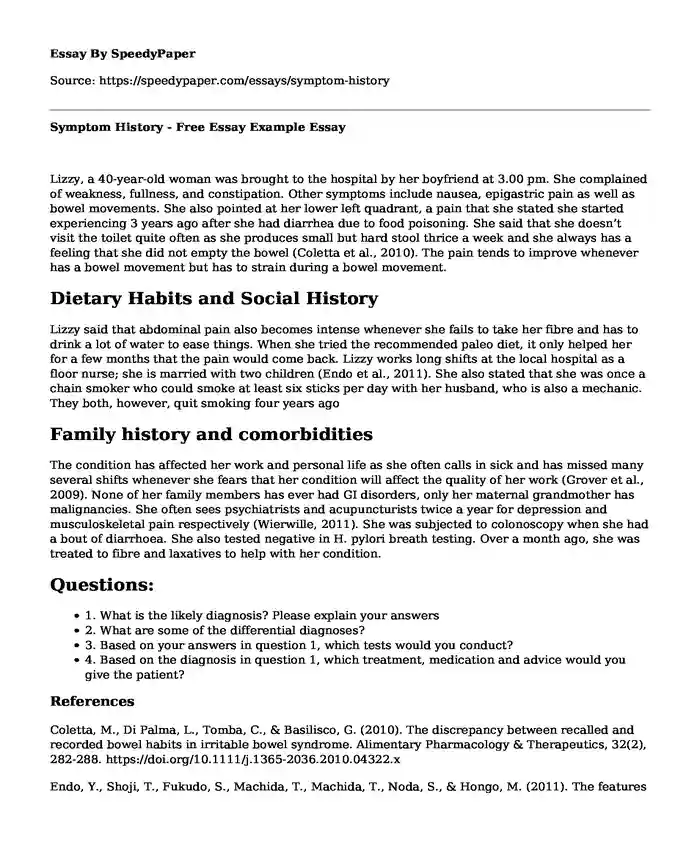Lizzy, a 40-year-old woman was brought to the hospital by her boyfriend at 3.00 pm. She complained of weakness, fullness, and constipation. Other symptoms include nausea, epigastric pain as well as bowel movements. She also pointed at her lower left quadrant, a pain that she stated she started experiencing 3 years ago after she had diarrhea due to food poisoning. She said that she doesn’t visit the toilet quite often as she produces small but hard stool thrice a week and she always has a feeling that she did not empty the bowel (Coletta et al., 2010). The pain tends to improve whenever has a bowel movement but has to strain during a bowel movement.
Dietary Habits and Social History
Lizzy said that abdominal pain also becomes intense whenever she fails to take her fibre and has to drink a lot of water to ease things. When she tried the recommended paleo diet, it only helped her for a few months that the pain would come back. Lizzy works long shifts at the local hospital as a floor nurse; she is married with two children (Endo et al., 2011). She also stated that she was once a chain smoker who could smoke at least six sticks per day with her husband, who is also a mechanic. They both, however, quit smoking four years ago
Family history and comorbidities
The condition has affected her work and personal life as she often calls in sick and has missed many several shifts whenever she fears that her condition will affect the quality of her work (Grover et al., 2009). None of her family members has ever had GI disorders, only her maternal grandmother has malignancies. She often sees psychiatrists and acupuncturists twice a year for depression and musculoskeletal pain respectively (Wierwille, 2011). She was subjected to colonoscopy when she had a bout of diarrhoea. She also tested negative in H. pylori breath testing. Over a month ago, she was treated to fibre and laxatives to help with her condition.
Questions:
- 1. What is the likely diagnosis? Please explain your answers
- 2. What are some of the differential diagnoses?
- 3. Based on your answers in question 1, which tests would you conduct?
- 4. Based on the diagnosis in question 1, which treatment, medication and advice would you give the patient?
References
Coletta, M., Di Palma, L., Tomba, C., & Basilisco, G. (2010). The discrepancy between recalled and recorded bowel habits in irritable bowel syndrome. Alimentary Pharmacology & Therapeutics, 32(2), 282-288. https://doi.org/10.1111/j.1365-2036.2010.04322.x
Endo, Y., Shoji, T., Fukudo, S., Machida, T., Machida, T., Noda, S., & Hongo, M. (2011). The features of adolescent irritable bowel syndrome in Japan. Journal Of Gastroenterology And Hepatology, 26, 106-109. https://doi.org/10.1111/j.1440-1746.2011.06637.x
Grover, M., Herfarth, H., & Drossman, D. (2009). The Functional–Organic Dichotomy: Postinfectious Irritable Bowel Syndrome and Inflammatory Bowel Disease–Irritable Bowel Syndrome. Clinical Gastroenterology And Hepatology, 7(1), 48-53. https://doi.org/10.1016/j.cgh.2008.08.032
Wierwille, L. (2011). Fibromyalgia: Diagnosing and managing a complex syndrome. Journal Of The American Academy Of Nurse Practitioners, 24(4), 184-192. https://doi.org/10.1111/j.1745-7599.2011.00671.x
Cite this page
Symptom History - Free Essay Example. (2023, Sep 08). Retrieved from https://speedypaper.net/essays/symptom-history
Request Removal
If you are the original author of this essay and no longer wish to have it published on the SpeedyPaper website, please click below to request its removal:
- Musculoskeletal Disorder - Free Essay with a Case Study
- Essay Example on Determining the Diagnosis of Iron Deficiency Anemia
- Paper Example: Professional Nursing and State-Level Regulations
- Paper Example. Evaluation and Epidemiology of Nocturia
- Increase in ADHD Diagnoses - Essay Sample
- Free Essay on Forensic Psychology in Legal Proceedings: Unraveling Complexities and Case Implications
- Research Finding - Free Paper Sample
Popular categories





